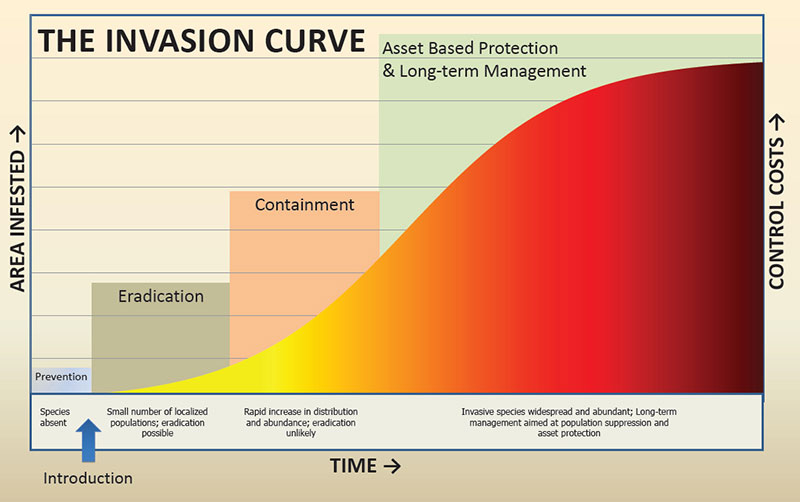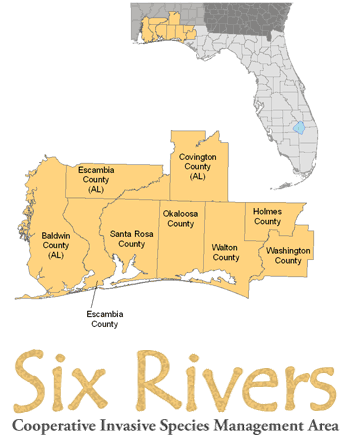Early Detection Rapid Response (EDRR)
To understand better what this is you can look at the graphic below of the “invasive species curve”.
You will notice that across the x-axis is time, increasing from left to right. On the y-axis you have area covered on the left and control costs on the right. You will notice the longer you allow an invasive species to go unchecked in your community, the more it will spread, the more it will cost to manage, and you will reach a point where eradication is no longer an option. As a matter of fact, if you are serious about eradication, you will need to manage this species in the early stages of the invasion.
We have mentioned in previous articles the cost of managing invasive species. Annually, the U.S. spends about $120 billion doing this. If you want to reduce these costs, and avoid the problems these species bring with them, you need to identify and remove them from the landscape early in the invasion.
Early Detection Rapid Response (EDRR) species are those that are not present in your community but are in nearby ones or are in your community but in very low numbers. You will see step 1 in the curve is to prevent the species from reaching you. The state of Florida is divided into 15 Cooperative Invasive Species Management Areas (CISMAs) where professionals within manage and educate the public about invasive species. One method of detecting a potential EDRR species is to see what nearby CISMAs are dealing with. You can find records of these species by searching EDDMapS, a national invasive species database (www.EDDMapS.org). Often the records are under reported and the actual number within/near your CISMA is higher. At that point you can educate your community about them and possibly prevent them from entering your CISMA. Likewise, if they are already within your CISMA in low numbers, it would be considered an EDRR species and action should be taken now.
Here in the western panhandle, we belong to the Six Rivers CISMA, which includes three counties in Alabama. During the shutdown of the pandemic, we were able to update our EDRR list and are currently developing fact sheets for each. Here is our EDRR list – it is in no particular order.
- Eurasian milfoil. This is an aquatic weed that was introduced via the aquarium trade. There are currently 12 records within Six Rivers and 12 in the eastern panhandle for a total of 24 records. There is quite a lot of this plant in the Mobile Delta area.
- Beach vitex. This is a beach/dune vine that eventually becomes a shrub. There are currently 83 records within the CISMA and five in the eastern panhandle for a total of 88 records. Almost all of the records are from the Pensacola Beach area.
- Argentine Black and White Tegu. This is a 3–4-foot lizard from South America that has caused a lot of problems in central and south Florida. There are seven records within Six Rivers and seven more from the eastern panhandle for a total of 14 records. There is no evidence of breeding populations here. It is believed these are escaped pets. One escape was from a breeder in the western panhandle, but all animals were captured but we keep an eye out.
- Callery (Braford) Pear. This is an ornamental tree that many have purchased and planted. There are 169 records within Six Rivers and another five in the eastern panhandle for a total of 174 records. This is most likely from better reporting in the Six Rivers, much of it coming from the Blackwater Forest area, where it is under management.
- Cane Toad. This is a large toad that produces a strong toxin that has killed dogs. It is a much larger problem in central and south Florida but there is one record within Six Rivers and another in the eastern panhandle for a total of two. Though there was a question on identification of the one within Six Rivers, it was eventually verified. Like the tegu, there is no evidence of breeding populations here, but we keep watch and remove if found.
- Channeled Apple Snail. This species is famous for the problems it has caused with the snail kites in central and south Florida. There are no records of it in Six Rivers and only two in the eastern panhandle, but it is feared that this species may be more common than the records suggest.
- Coral ardisia. This is a beautiful plant that produces beautiful red berries but is a problem. It takes over patches in hardwood habitats and has invaded natural areas. There are 14 records within Six Rivers and 407 in the eastern panhandle for a total of 421 records. This plant may have originally escaped cultivation in the eastern panhandle hence the high numbers there.
- Cuban Treefrog. This is a large treefrog that consumes all others, as well as other forms of wildlife. There are 13 records within Six Rivers and 19 in the eastern panhandle for a total of 32 records. There has been increasing number of reports from the Six Rivers CISMA suggesting that this is a species that needs immediate attention.
- Giant Salvinia. This is floating plant that resembles duckweed, but the leaves are larger. There are 10 records within Six Rivers and two more in the eastern panhandle. These are the only known records of this plant in the entire state. Those within Six Rivers are in Bayou Chico. There is an effort by FWC to eradicate this plant, but public help is needed.
- Green Mussel. This is a beautiful emerald, green mussel that grows in clumps on pilings and rocks in marine waters. There is only one record within Six Rivers and no records from the eastern panhandle. The lone specimen was found in Pensacola but was not verified. It is a problem in peninsula Florida so keeping an eye out for it is smart.
- Greenhouse Treefrog. This is a very small treefrog that has been found in local gardens. There are five records from Six Rivers and two others from the eastern panhandle for a total of seven records, but it is believed to be more common than this.
- Guinea Grass. There are 18 records of this plant within Six Rivers and five additional from the eastern panhandle for a total of 23 records.
- Hydrilla. This is another aquatic grass brought in for the aquarium trade. There are eight records within Six Rivers and 28 from the eastern panhandle for a total of 36 records. This is a big problem in the peninsula part of the state, and we spend a lot of money controlling it.
- Natal Grass. This is a wiry grass that grows in more open fields and has a pretty tuft of small red flowers at the top giving the landscape an interesting reddish look – but it is invasive and needs to be controlled. There are 31 records from Six Rivers and 21 more from the eastern panhandle for a total of 52 records.
- Skunk Vine. There is only one record within Six Rivers, but this is probably under reported. There are an additional 16 records from the eastern panhandle for a total of 17 records.
- The Snail. It is called “the snail” because no common name has been given. The scientific name is Bulimulus sporadicus and it appears to have been introduced in the Jacksonville area. From there the snail seems to have followed the railroad lines, possibly from cargo, and has begun to spread. There are no official records from EDDMapS from the Florida panhandle, but it has been found by many gardeners. More needs to be learned about this potential threat and more records are needed.
- Swamp Morning Glory. This is an aggressive growing vine that has been problematic for property owners who have it. Currently, there are only two records from Six Rivers and no records from the eastern panhandle, but this is probably another under reported species.
- Water Hyacinth. This is a well-known floating plant with beautiful purple flowers. But it will overtake waterways quickly changing the entire ecosystem and potential hampering economic opportunities within those waterways. There are 21 records within Six Rivers and 256 in the eastern panhandle for a total of 277 records.
These are the EDRR species for our area. As mentioned, they are under reported and help is needed to improve this. Help is also needed in preventing the spread of them. Cleaning equipment, like tractors, ATVS, and boats before moving is a good start. Being mindful of what you purchase at the store, and what may be “hitchhiking” on it is another good practice to help. And, if you do find on your property, reporting and removing it will also help.
If you have questions about identification and safe methods of removal, contact your county extension office. Tomorrow we will look at the “Dirty Dozen” invasive species for the Florida panhandle.
- Our Environment: Part 10 – Improving Agriculture - June 20, 2025
- Marine Creatures of the Northern Gulf – Snails and Slugs - June 20, 2025
- Our Environment: Part 9 – Agriculture Challenges - June 6, 2025



